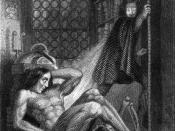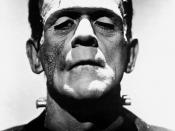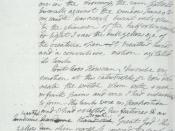Analyse the 'creation scene' from Mary Shelley's 'Frankenstein' and compare it to Kenneth Branagh's 1994 film version of the same.
One of the key themes in Mary Shelley's 'Frankenstein' is human arrogance. Frankenstein's curiosity leads him to play the role of God. In a way Frankenstein is responsible for the monster and has ultimately become a father figure to the monster. Frankenstein abandoning the monster leads up to it turning evil and looking for revenge. Therefore, parenting is another theme in the novel. The nature of beauty is another theme. Frankenstein abandons the monster because he did not turn out as good looking as he had intended. The best features were chosen to make Frankenstein's monster but ironically the monster turned out ugly.
The 'creation scene' is presented in a typically 'Gothic' way and Shelly exploits the gothic traditions that had already, to some extent, been established in 1818.
Her setting is classic of the genre as her setting is very hellish. The candles, coffins and dreary night are commonly used for this genre. Her use of archaic language gives us the classic gothic feeling. Language like "demonical corpse", "convulsed" "grave-worms". The archaic language is also a good use of graphic imagery, which again is classically used in this type of genre. Shelley also uses hyperbolic language. She seems to over exaggerate a lot of things in this scene. For example, she uses repetition and exclamation marks to show how shocked Frankenstein was when he first saw the monster: "beautiful. Beautiful! - Great God!". The capital letters also show us the shock. Frankenstein is over reacting.
Shelley uses false collocations to contrast evil and good. Words that would not normally go together are put together:
"Horror and disgust filled my heart"
Usually the phrase is 'hope and...


